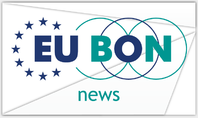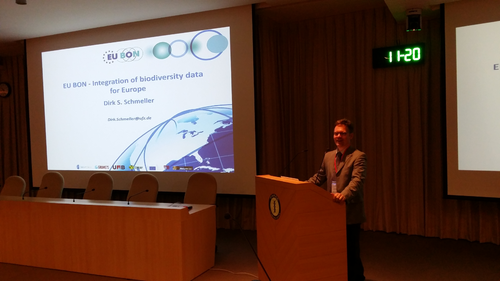

The 2013 International Conference on Open Data in Biodiversity and Ecological Research took place between 20 - 22 Nov 2013, hosted by Academia Sinica in Taipei, Taiwan. With the aim to promote open data in science twelve foreign speakers introduced relevant projects and initiatives in the sphere of biodiversity informatics: AP-BON, DataONE, Ecological Research, EU-BON, Global Biodiversity Information Facility (GBIF), Japan Biodiversity Information Facility (JBIF), linked open data, National Ecological Observatory Network (NEON), Pensoft, and Thomson Reuters.

Dirk Schmeller (UFZ) and Lyubomir Penev (Pensoft), who presented EU BON at the conference, share their experience in a recent interview:
 |
| Lyubomir Penev (Pensoft) |
What are the aims and main outcomes from this meeting?
LP: Taiwan has an impressive national policy with regard to data management in biodiversity sciences. The meeting summarised years of effort of Taiwanese scientists and especially of Academia Sinica to integrate data and make them publicly available. It is sufficient to mention that Taiwan has established four national nodes of the largest international biodiversity platforms, that is TaiBIF (of GBIF), TaiCOL (of Catalogue of Lige), TaiEOL (of EOL) and TaiBOL (of Barcode of Life).
Were there any biodiversity data integration models presented at the meeting that can be adopted and implemented in EUBON?
LP: Perhaps not directly, however the impressive amount and quality of work and the accumulated experience of the Taiwanese and Japanese colleagues would certainly be of value for EU BON. In addition, there are well established contacts already between the FP7 project SCALES and the National University of Taiwan which could serve as a stepping stone as well, because two of the SCALES partners participate in EU BON and at the meeting (UFZ and Pensoft).
The interest to the EU BON presentation by Dirk was great. An indicator for that was that more than 120 EU BON leaflets have been picked up by the participants from the information desk.
Did you discuss any opportunities for partnership with organizations and initiatives from Asia and America, which deal with biodiversity data integration and accessibility?
LP: Yes, there were a lot of discussions how to mobilize and publish biodiversity data and most probably several data publishing projects will appear as a result of the discussions. These pilots could be used for the EU BON goals.
 |
| Dirk Schmeller (UFZ) |
US National Ecological Observatory Network (NEON) has activities similar to those planned by WP4 Link environment to biodiversity: analyses of patterns, processes and trends. Is there something that EU BON can learn from the experience of its American colleagues?
DS: It is important to keep a close link with Brian Wee and NEON, as they have a head start in comparison to EU BON. I am sure that a collaboration would benefit EU BON to work efficiently.
What is your prognosis for the successful establishment of the data publishing model in scholarly literature, and more specifically in spheres such as Ecology, Genetics, Physiology and Paleontology?
DS: Most research is financed by taxpayer money and should become publicly available once the analyses a researchers has intended are completed. I see a huge potential to publish this data in scholarly literature. I, however, see also quite some difficulties to recombine relevant datasets across different sources for further going analyses. I also see difficulties in the willingness of researchers to share data, as in many cases they see these as their own.
Linked Open Data (LOD) is a new and prominent technology to publish and share data on the web. Could you please explain what exactly hides behind this concept, and how could EU BON benefit from it?
LP: The meeting in Taiwan was impressive also in the wide representation of the Resource Description Framework (RDF) technologies in integration of biodiversity data, especially from a group from the National Museum of Japan and the University of Tokyo. RDF and the OWL Web Ontology Language are definitely the way to go if we want to make diverse data sets interoperable; the implementation of RDF in a pilot phase would be of primary importance for the success of EU BON.




 RSS news
RSS news Print this article
Print this article
